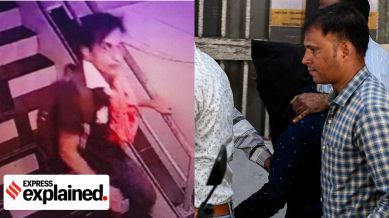Saif Ali Khan case accused photos match CCTV footage, says forensic lab. How is this done?
Some people claimed that the CCTV footage available in the media did not seem similar to the arrested man’s photograph. How is facial recognition done in such cases?

The Mumbai police on Friday (January 31) said the state Forensic Science Laboratory (FSL) reported a match between the man arrested for attacking Bollywood actor Saif Ali Khan at his residence and CCTV footage from Khan’s building.
Some concerns were earlier raised about the attacker’s identity, as the footage available in the media did not appear to be similar to the arrested man’s photograph. In such cases, how is facial recognition done? We explain.
monthly limit of free stories.
with an Express account.
How does facial recognition work in police cases?
According to a former official with the Maharashtra FSL, facial recognition was carried out manually until the early 2000s, relying on anthropometric recognition. Here, the precise measurements of facial features, like the distance between the eyes, the size of the forehead, and the width of the mouth, nose, hairline, and chin, are extracted from the photographs for comparison.
This information can be used for photogrammetry, a method for approximating a three-dimensional (3D) structure using images. Today, both the manual method and software are used to compare photographs. The official said that earlier they would also use X-rays of the skull and then employ facial superimposition (overlaying one photo on top of another to find a match).
Apart from accounting for physical features, the software considers the angle from which the photo is taken, how light falls on the face, the image quality, and the camera distance. Display fidelity, the degree to which the real world is accurately reproduced in a photo, is also checked.
The footage available in Khan’s case captured the accused from his right side and had a night vision camera light in addition to the tube light. However, police officials said the image of the accused seen in the media is not the only one and nearly 20 other images from multiple CCTV cameras were sent for testing.
How many facial features must match for a positive report?
An official said that if the parameters match absolutely, then the FSL report states the two faces are “similar with details”. This is rare. Usually, when there is a match in more than six or seven visible parameters of the nearly 10 that are compared, the report states they are “similar”.
If the images are unclear, they try digital enhancements. If that does not work and only a few features are clear, they state in their report that all features are not visible and only X number of comparable features match, which is inconclusive.
However, there has been some criticism of such processes’ accuracy. In 2019, the US government’s National Institute of Standards and Technology (NIST) analysed facial recognition algorithms developed by private companies (such as for unlocking phones) and submitted a report saying most algorithms were more likely to misidentify a Black or East Asian face than a white face. It said the data used to train the algorithm may be a factor here.
The report added, “A general takeaway from these studies is that, there is significant variance between the performance facial recognition algorithms, that is, some produce significantly fewer errors than others. Consequently, users, policy makers, and the public should not think of facial recognition as either always accurate or always error prone.”
What happens if the facial recognition technique is inconclusive?
Other samples have to be relied upon. An official said that the most scientifically accurate identifier is the DNA test, favoured by law enforcement agencies. Techniques like facial recognition and fingerprint identification are used in the absence of DNA samples (like blood or hair). These were the main identifiers when DNA tech was still nascent a few decades ago.
If they too prove inadequate, other identifying techniques like gait analysis and body structure analysis are done. In gait analysis, the person’s manner of walking is matched with what was captured on the CCTV camera. It was done in the Antilia bomb scare case in Mumbai for dismissed cop Sachin Waze. Body structure tests compare the size of limbs and other features.
How much evidentiary value do these reports carry?
An official said that a DNA report is considered a stronger piece of evidence compared to other analyses. In any case, during the trial, the defence can cross-question the forensic official who carried out these tests and ask questions about the process. Depending on how the official responds, the court considers the testimony.